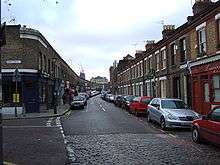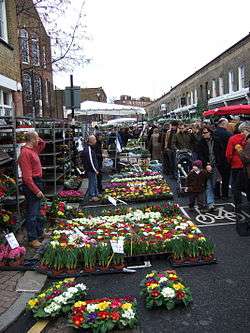Columbia Road Flower Market
|
Flowers for sale | |
| Location | Bethnal Green, Tower Hamlets, Greater London |
|---|---|
| Coordinates | 51°31′46″N 0°04′10″W / 51.5294°N 0.0694°WCoordinates: 51°31′46″N 0°04′10″W / 51.5294°N 0.0694°W |
| Address | Columbia Road |
| Management | Tower Hamlets London Borough Council |
| Owner | Tower Hamlets London Borough Council |
| Environment | Outdoor |
| Goods sold | Flowers and plants |
| Days normally open | Sunday |
| Number of tenants | 49 |
| Website |
www |
Columbia Road Flower Market is a street market in East London, England. Columbia Road is a road of Victorian shops off Hackney Road in the London Borough of Tower Hamlets. The market is open on Sundays only.[1]
History
Columbia Market was built upon an area known as Nova Scotia Gardens. This had been a brick field, north-east of St Leonard's, Shoreditch, the brick clay had been exhausted and the area begun to be filled in with waste (leystall). Cottages (probably evolving from sheds, serving the gardens), came to be built here, but were undesirable as they remained below ground level, and so were prone to flooding.[2]
- London Burkers
In July 1830, John Bishop and Thomas Williams rented no. 3 Nova Scotia Garden, from a Sarah Trueby. Together with Michael Shields, a Covent Garden porter, and James May, also known as Jack Stirabout and Black Eyed Jack, they formed a notorious gang of Resurrection men, stealing freshly buried bodies for sale to anatomists. On 7 November 1831 the suspiciously fresh corpse of a 14-year-old boy was delivered, by these men, to the King's College School of Anatomy, in the Strand. Joseph Sadler Thomas, a superintendent of police, searched the cottages at Nova Scotia Gardens, and found items of clothing in a well in one of the gardens, and also in one of the privies, suggesting multiple murders. The Resurrection men were arrested, and by an extraordinary arrangement, the police opened the premises for viewing, charging 5 shillings. The public carried away the dwelling, piece by piece, as souvenirs. Bishop and Williams were hanged at Newgate on 5 December 1831 for the murder.[3] The police had tentatively identified the body as that of Carlo Ferrari, an Italian boy, from Piedmont, but at their trial Bishop and Williams admitted it to be that of a Lincolnshire cattle drover, on his way to Smithfield.[4]
By 1840, the area had degenerated into a notorious slum. It is for this reason that the philanthropist Angela Burdett-Coutts purchased the land, and established Columbia Market.
- Origins of Columbia Market
Angela Burdett-Coutts established Columbia Market in 1869 as a covered food market with 400 stalls. Her secretary and future husband William Burdett-Coutts came to own the market, and built up a considerable fishing fleet in the North Sea.[5] He was involved in a planned railway line for the delivery of the fish to the market; but competition from Billingsgate Fish Market meant that it was never built, and traders preferred selling outdoors. The market closed in 1886, after use as warehouses and small workshops. Prompted by Charles Dickens, Angela Burdett-Coutts also built the separate U-shaped Columbia Dwellings, of several storeys, with a three-storey Gothic arch built into the brickwork of the central section. The building was demolished in 1958,[6] although the remains of railings can be seen in front of the Nursery School. Sivill House and the Dorset Estate replaced the Coutts buildings.

Recent history
The Columbia Road flower market began as a Saturday trading market. It was moved to Sunday, by Act of Parliament, in order to accommodate the needs of local Jewish traders. This also provided the opportunity for Covent Garden and Spitalfields traders to sell their stock left over from Saturday. The enduring interest and demand for cut flowers and plants were introduced to the East End by Huguenot immigrants (driven from France after 1685 by the revocation of the Edict of Nantes), together with a fascination for caged song birds[7] – the pub at the end of the market is called The Birdcage.
The market suffered in World War II from rules prioritising food production, and went into a long decline. A large civilian shelter beneath the market suffered a direct hit by a 50 kg bomb on the night of Saturday, 7 September 1940, at the height of The Blitz.[8] From the 1960s, new rules forced traders to attend regularly, and the market enjoyed a new resurgence with the increasing popularity of gardening programmes.
- Modern market

The market is in operation every Sunday from 8 am to 2 pm. Traders arrive from 4 am to set up their stalls. A wide range of plants, bedding plants, shrubs, bulbs and freshly cut flowers is available at competitive prices. Many of the traders are the second or third generation of their family to sell at the market.[9]
The market also has shops selling bread and cheeses, antiques, garden accessories, unusual international edibles, soap, candlesticks and Buddhist artefacts.
Much of Columbia Road is part of the Jesus Green Hospital Estate.
The market is popular not only with plant and flower buyers but also with photographers and television companies, who frequently film there.
Transport
The market is some distance from Liverpool Street station and Bethnal Green and Old Street tube stations; but is well served by bus routes 26, 48 and 55, and 8 and 388 from Bethnal Green Road. Hoxton station, on Cremer St, is close.
Parking restrictions and eager traffic wardens make parking near the market difficult. One solution is to park free of charge on the Hackney side of Hackney Road where traffic wardens do not operate on a Sunday.
Notes and references
- ↑ http://www.nmtf.co.uk/markets.php?id_mar=388
- ↑ 'Bethnal Green: The North West: Hackney Road', A History of the County of Middlesex: Volume 11: Stepney, Bethnal Green (1998), pp. 112-14 date accessed: 21 January 2007.
- ↑ Newgate Calendar Vol.5 (1831) accessed 21 January 2007
- ↑ In the same year, Catherine Walsh of Whitechapel, who made her living by selling laces and cotton, was murdered by Edward Cook. His accomplice, Elizabeth Ross, sold the body to surgeons. Both were hanged for the murder.
- ↑ Debrett's Guide to the House of Commons 1886, p.34
- ↑ 'Bethnal Green: Building and Social Conditions from 1837 to 1875', A History of the County of Middlesex: Volume 11: Stepney, Bethnal Green (1998), pp. 120-26 Date accessed: 21 January 2007
- ↑ 'Spitalfields', Old and New London: Volume 2 (1878), pp. 149-52 accessed: 8 February 2007
- ↑ Personal account of the bombing, at BBC online accessed 21 January 2007
- ↑ http://www.onlondontime.co.uk/2011/05/columbia-road-flower-market.html
See also
Bibliography
- Helen MacDonald - Legal Bodies: Dissecting Murderers at the Royal College of Surgeons, London 1800-1832 - in Traffic: An Interdisciplinary Postgraduate Journal, No.2, 2003 pp.9-32 ISSN 1447-2538
- Sarah Wise - The Italian Boy: A Tale of Murder and Body Snatching in 1830s London (Metropolitan Books, 2004) ISBN 0805075372
- Image of the 'Burker' cottages, at City of London library
External links
- www.columbiaroad.info - Columbia Road Main Site
